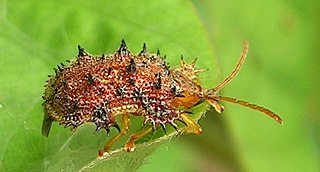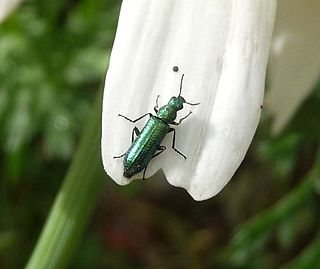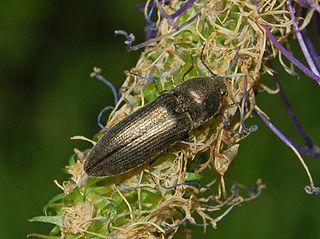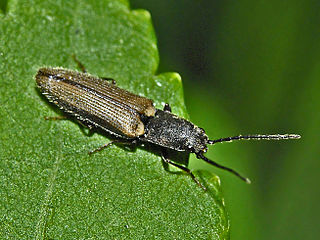Related Research Articles

The insects of the beetle family Chrysomelidae are commonly known as leaf beetles, and include over 37,000 species in more than 2,500 genera, making up one of the largest and most commonly encountered of all beetle families. Numerous subfamilies are recognized, but the precise taxonomy and systematics are likely to change with ongoing research.

Prostomidae is a family of beetles with no vernacular common name, though recent authors have coined the name jugular-horned beetles. They are often found in dead wood. The family consist of two genera with about 20 species. Prostomis mandibularis is known from North America. Other species of Prostomis are found in Africa, the Pacific region and East Asia. Species of Dryocora are known from New Zealand, Australia and Tasmania.

The Cassidinae are a subfamily of the leaf beetles, or Chrysomelidae. The antennae arise close to each other and some members have the pronotal and elytral edges extended to the side and covering the legs so as to give them the common name of tortoise beetles. Some members, such as in the tribe Hispini, are notable for the spiny outgrowths to the pronotum and elytra.

Trox scaber is a beetle of the Family Trogidae. The 5 to 8 mm long insect is found worldwide, including in Europe, and lives in bird nests

Chrysolina grossa, the red leaf beetle, is a species of broad-shouldered leaf beetles belonging to the family Chrysomelidae, subfamily Chrysomelinae.

Exosoma lusitanicum or daffodil leaf beetle is a species of skeletonizing leaf beetles belonging to the family Chrysomelidae, subfamily Galerucinae.

Psilothrix viridicoerulea is a species of soft-winged flower beetles belonging to the family Melyridae, subfamily Dasytinae.

Cidnopus pilosus is a species of click beetle belonging to the subfamily Dendrometrinae of the family Elateridae.

Chrysanthia viridissima is a species of beetles belonging to the family Oedemeridae subfamily Nacerdinae.
Abacetus pumilus is a species of ground beetle in the subfamily Pterostichinae. It was described by Boheman in 1848. Abacetus pumilus is a small, but distinctive, beetle with red legs and antennae, and a green tinge on its wings. Very little is known about Abacetus pumilus habitat, however it is found throughout the arid deserts and semi-arid steppes of southern Africa.

Chlorophorus varius, the grape wood borer, is a species of beetle in the family Cerambycidae.

Athous bicolor is a species of click beetles.

Tillus elongatus is a species of beetle in the Family of checkered beetles Cleridae. It is found in the Palearctic. The “Holz” in the German common name Holzbuntkäfer indicates that these checkered beetles are found in wood. Although Tillus elongatus can reach up to a size of 1 cm long, the beetle is rarely seen by humans, as it primarily resides hidden in the wood of trees. The colouration of the males differs from that of the females.
Coniomma is a genus of leaf beetles in the subfamily Eumolpinae. It contains only one species, Coniomma hospes, and is endemic to the island of Luzon in the Philippines. The genus and species were first described by Julius Weise in 1922, and were re-described in 2011 by A. G. Moseyko. The genus is very closely related to Rhyparida, from which it is separated mainly by the shape of the eyes and the length of the antennae.

Clanoptilus barnevillei is a species of beetles belonging to the family Melyridae, the soft-winged flower beetles.
Holotrichia danielssoni, is a species of dung beetle found in Sri Lanka.

Liatongus rhadamistus, or Scaptodera rhadamistus, is a species of dung beetle found in India, Sri Lanka, Laos and Thailand.
Arixyleborus malayensis, is a species of weevil found in India, Sri Lanka, China, Japan, Malaysia, Vietnam and Indonesia. This is the only species of Arixyleborus found in Japan and China.
Arixyleborus mediosectus, is a species of weevil found in India, Sri Lanka, Cambodia, Myanmar, Phillipines, Malaysia, Indonesia: Sumatra and Vietnam.
Arixyleborus rugosipes, is a species of weevil native to India, Sri Lanka, Philippines, Malaysia, Borneo, Vietnam, Indonesia, and in Australia, Japan, Korea, New Zealand as an exotic species.
References
| Wikispecies has information related to Chrysanthia superba . |
| Wikimedia Commons has media related to Chrysanthia superba . |